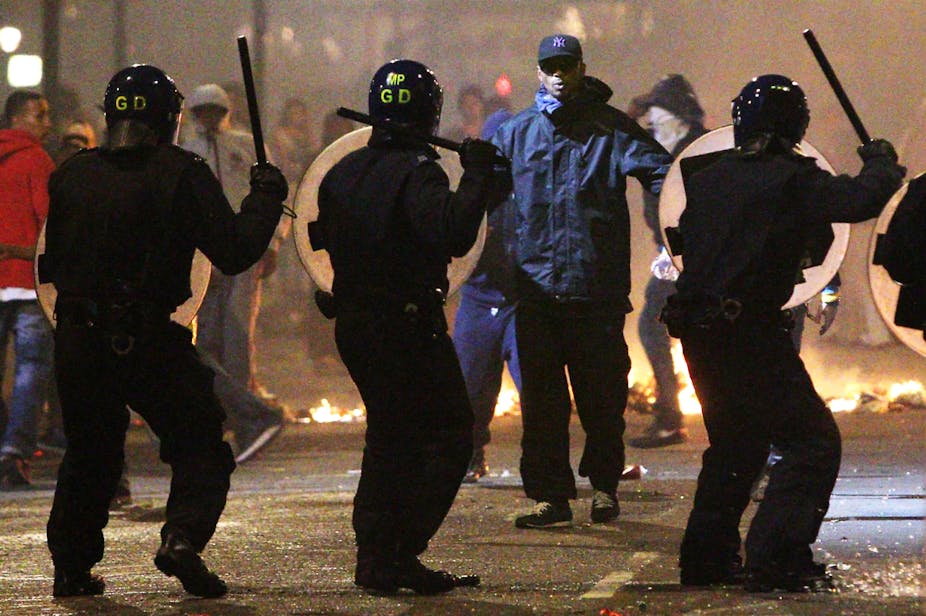There has been a surge in violent crime across the UK during 2018, including a 22% increase in knife crime and an 11% rise in gun crime. Homicide rates have hit their highest point in over a decade. In London alone, there have been 123 homicides so far this year, including 70 fatal stabbings and 14 shootings.
Politicians, journalists and experts have blamed a wide range of factors for this upswing in violence: gangs, drill music, drug turf wars, austerity, police cuts and dwindling youth services. But having researched serious youth violence in London for more than a decade, we believe that the root of this issue goes far deeper.
Studies have shown that when the public’s trust in the government and its elected officials goes down, violence goes up. In other words, if people feel society is unfair, they are less inclined to play by the rules and more likely to lash out violently.
Losing legitimacy?
From the handling of Brexit to the fire at Grenfell tower, the miscarriage of justice at Hillsborough and the Windrush scandal, there are plenty of reasons why British people might distrust their political leaders.
And due to the rise of “fake news”, there’s also growing distrust of the institution designed to hold elected officials to account – the media. Social media platforms – plagued by extremism, trolling and disinformation – kindle and spread moral outrage, whether it’s based on real events or not.

For people of colour – who are disproportionately the victims and perpetrators of knife crime in London – the casual racism they encounter every day on social media can make the world feel especially unfair and unstable.
The annual trust barometer survey by PR firm Edelman found that British people hold “little hope for the immediate future”. And while trust in traditional broadcasters and publishers has risen significantly, more people are switching off from news, and overall levels of trust in government, media and business are flat lining. And that’s before the Cambridge Analytica data scandal or the recent Brexit negotiations.
In a social and political climate such as this, combined with the strains of austerity, the small disagreements, indignities and disappointments, which people might otherwise brush off, enrage them. And this creates scope for the two principal forms of aggressive behaviour – defensive rage and predatory attack — to emerge.
A trust deficit
As violence has risen, the proportion of offences for which police have identified the culprit has fallen, and this further erodes civilians’ trust in authority. In 2017, Her Majesty’s Inspectorate of Constabulary described the shortage of police investigators — including detectives — as a “national crisis”. Even London’s Metropolitan Police Service is short some 700 detectives.
In October 2018, MPs warned that police could become “irrelevant” with so few officers on the beat. Many neighbourhoods with high crime are already inclined to distrust police, owing to their experiences of abuse and institutional racism. When police fail to solve crime, people will often bypass law enforcement altogether, instead using violence to resolve disputes.
Not only that, growing tensions between police and communities can lead to further criminality, because successful police work depends heavily on cooperation with the public. When police fail to provide sufficient deterrence to crime, some people feel they can stab and shoot without fear.

Just as widespread anger and frustration at police was part of what triggered the 2011 UK riots, a crisis of legitimacy might well be the catalyst for rising violence today.
What’s past is prologue
History is important here. In London, 54 teenagers were stabbed to death throughout 2007 and 2008. Then, as now, people scrambled to explain the trend, accusing “broken families” and “black culture”. But 2007 and 2008 were also times of deep distrust. The global financial crisis and the resulting recession confirmed civilians’ worst fears that the strength of the economy was compromised by the risky behaviours of financial institutions deemed “too big to jail”.
Young people leaving school and entering the labour market for the first time were the hardest hit, and today their future still looks uncertain – thanks in part to mounting student debt and the end of free movement. And when feelings of distrust course through society, young people who have experienced severe adversity in their lives already, or who have been let down by institutions in the past, are especially vulnerable.
The root of the problem is that people don’t like division and uncertainty. They are frustrated, angry; and with no outlet for that anger, and no legal recourse, violence continues to creep upward. Some have directed their anger outward to assault and homicide. Others have directed it inward in the form of self harm and suicide — also increasingly prevelant among Britian’s youth.
It’s not enough to approach rising violence as a public health problem, which could be solved with appropriate investment in social safety nets such as youth services, social care and early intervention. Government officials and institutions must also act with integrity and moral courage.
People need to believe that others are operating in their best interests; that violent offenders will be held accountable; and that better days are ahead. That’s why the first step towards reducing violence is repairing public trust in authority.

